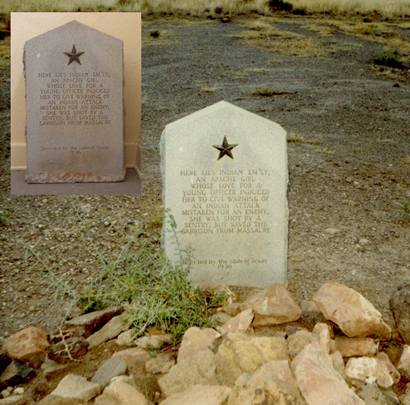|
|
One
of the most romantic stories in the lore of the Old West originated
at Fort Davis.
The tale has been told and retold in all media. And now it’s on the
internet. It’s the story of Indian Emily and goes like this:
In the late 1860s, an Apache female fell wounded in a skirmish between
cavalry troops stationed at Fort
Davis and her band. The soldiers took her back to the fort, where
a Mrs. Eason nursed her back to health and named her Emily. The Indian
girl grew up on the post and eventually fell in love with Mrs. Eason’s
son, Lt. Tom Eason. |
Ft. Davis and
its Buildings c. 1950
Photo Courtesy TXDoT |
But the soldier
married a girl of his own culture and the broken-hearted Emily returned
to her people.
Some time later, so the story goes, the Apaches planned a major assault
on the fort. Emily, in an act of selfless love, slipped away from
her village in the middle of the night to warn the young officer.
As she approached the fort a jittery sentry shot her. She died in
Mrs. Eason’s arms after telling her of her everlasting love for Lt.
Eason and of the impending attack on Fort Davis.
They buried Indian Emily in the post cemetery. After the Army abandoned
the garrison in 1891, the graves of most of the soldiers were relocated
to the National Cemetery in San
Antonio. Emily, however, was left behind. |
The
story goes back to 1919, when Carlyle Graham Raht included it in his
book, “Romance of the Davis Mountains and the Big Bend Country.”
Raht said he got the tale confirmed by Henry O. Flipper, the first
African-American graduate of West Point and a one-time lieutenant
at Fort Davis.
During the Texas centennial
in 1936, the state placed a granite marker at Emily’s grave. The
inscription reduced her story to 38 words, concluding that she had
“saved the garrison from massacre.”
|
|
|
Alas, though
touching, the account of Indian Emily and her valiant death is pure
folklore.
In
1969 as a reporter for the San Angelo Standard-Times, I had a hand
in exposing it as such. I interviewed Franklin Smith, then superintendent
of the Fort Davis National Historic Site, and asked him about the
Indian Emily story.
“All evidence points against it,” he said.
In fact, he continued, National Park Service historians had refuted
every aspect of the story.
For one thing, Smith said, the National Archives had no record that
a Lt. Tom Eason was ever stationed at the fort. Further, researchers
had found no record a person by that name ever served in the U.S.
Army prior to 1903.
The park superintendent said the military kept pretty good records,
better than most people would think.
Those records also showed that Fort Davis never experienced an attacked
by hostile Indians and that no attack ever had been seriously anticipated.
Smith, who had done socio-anthropological studies of the Apache
culture, also said Emily did not behave like an Apache woman in
the story. “Her general behavior was, well…very un-Apache,” he said.
Though the legend has Emily being wounded during the fight with
the soldiers, according to Smith, “Apache women didn’t do any fighting
except under dire circumstances.”
Too, the circumstances of her supposed capture did not ring true.
“Normally,” he said, “when Indian dependents were captured, they
were cared for as best as the Army could. They were usually farmed
out to boarding schools. They were not normally kept around the
forts.”
Smith said someone likely dreamed up the story after reading one
too many Victorian romances.
Sometime after my interview with Smith the NPS removed the piled
stones from Emily’s purported grave, cut off access to the site
and even took down the heavy historical marker, storing it along
with other artifacts associated with the fort.
|
 |
Indian Emily
Marker in storage today
Photo courtesy Barclay
Gibson, May 2009 |
|
The
late Barry Scobee, one of the frequent tellers of the Indian Emily
story, went to his own grave believing it contained at least some
elements of truth. He set forth two pieces of circumstantial evidence
in his 1963 history of Fort Davis.
Scobee’s Exhibit A came from a military report describing an engagement
between three companies of Fort Davis troops under Lt. Patrick Cusack
and a party of Indians on Sept. 8, 1868. Following the fight, Cusack’s
command returned to the fort with two Mexican children who had been
captured by the Indians and “an Indian female child.”
Since local lore had Emily’s death occurring in 1879 or ’80, Scobee
wrote, the child brought in by Cusack more than a decade earlier
could have been Emily.
The writer offered as Exhibit B the recollection of David Merrill,
the man who got the government contract to exhume the Fort Davis
post cemetery. Merrill related that the military told him to dig
up all the remains except for a soldier who had committed suicide
and an Indian woman. He said he removed 89 sets of remains, though
a later account has the number at 83. No matter the count, he did
not remove the Indian burial.
Scobee wrote that the grave had been marked by a board bearing an
inscription that said “Indian Squaw—Died by Accident.” By the time
the state put up the historical marker, Scobee continued, the board
had disappeared. Warren D. and Herbert D. Bloys, local old timers,
pointed out the grave’s location and recalled the no-longer politically
correct wording of the wooden grave marker.
As Scobee wrote: “These bits of ‘evidence’…constitute the supporting
circumstances of Emily’s reality.”
For a story teller, killing off a legend is a mighty hard thing,
almost as tough as putting down a good horse with a broken leg.
Fortunately, a story does not have to be true to be engaging.
© Mike Cox
"Texas Tales" October
2, 2008 column
|
|
|
